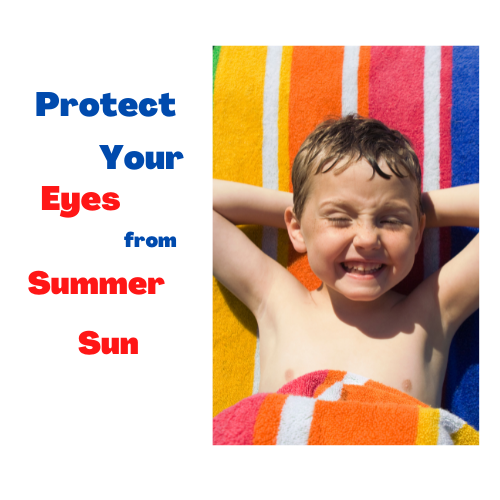Summer Eye Protection from the Sun


Summer eye protection from the hot sun is essential as we all move outdoors for our vacations and recreation.
A painful eye condition known as photokeratitis or ultraviolet keratitis is caused by exposure to ultraviolet radiation. It is essentially sunburned eyes and affects the thin surface layer of the cornea—the clear front part of the eye, and the conjunctiva which is the clear tissue that covers the white part of the eye.
The condition can be caused by sun reflected from sand, water, ice or snow. There are also manufactured sources of ultraviolet light such as tanning lamps, tanning beds, and arc welding.
And like sunburned skin, the problem is not noticed until after the damage has occurred. Symptoms of ultraviolet keratitis include:
- Pain
- Redness
- Blurriness
- Tearing
- Gritty feeling
- Swelling
- Sensitivity to bright light
- Headache
- Seeing halos
- Eyelid twitching
Although ultraviolet keratitis can happen in any season, summer is when people spend a lot more time outdoors so eye protection from the summer sun is a good way to not only prevent ultraviolet keratitis, but it can reduce your risk of developing cataracts.
Wear sunglasses – This is a summertime essential and the bigger the better. Sunglasses that wrap around protect your eyes from the UV rays that can come in from the sides of conventional sunglasses. If you wear glasses you can find sunglasses designed to fit over glasses. Or you can have your glasses made with photochromic lenses that darken in the presence of UV rays and block 100% of UV rays.
Make sure your sunglasses provide adequate eye protection from ultraviolet light. Sunglasses that are 400 UV means that they block wavelengths up to 400 nanometers which includes 100% of both UVA and UVB rays.
Summer Eye Protection from UV Radiation?
Ultraviolet radiation is a part of the electromagnetic energy produced by the sun. Ultraviolet light has shorter wavelengths than visible light and there are two types.
- Ultraviolet A (UVA) rays have a lower amount of energy and a longer wavelength and they can enter the middle layer of skin, called the dermis. UVA waves from 90% of the UV radiation that reaches the earth.
- Ultraviolet B (UVB) rays have slightly more energy and a shorter wavelength and can only penetrate the outer layer of skin, called the epidermis. UVB rays are linked to skin burning and have a role in the formation of skin cancers.
What are Polarized Sunglasses
Polarized lenses have a chemical film applied that is composed of molecules that naturally align in parallel relation to one another. This creates a microscopic filter that absorbs any light that matches their alignment. Most glare comes from horizontal surfaces such as a lake, a beach, or a highway. Polarized sunglasses will only allow vertically polarized light to enter and so the glare from horizontal surfaces is blocked.
Seek Out Shade
When you are at the beach, use a beach umbrella. If you are watching a sporting event in a lawn chair, get an umbrella that attaches to your chair or wear a sun hat. Wide-brimmed sun hats provide protection from UV rays. And of course the time-honored summer tradition of sitting in the shade of a tree is also a good option to protect yourself from UV rays.
Protect Your Eyes in the Water
This is not about sun protection for your eyes, but good to remember and follow to keep your eyes safe while enjoying summertime swimming. Chlorine is used in pool water to prevent bacterial growth, but it can also cause eye irritation. Swimming in a lake or the ocean can introduce bacteria into your eyes. Protect your eyes while swimming by wearing goggles. Rinsing your eyes after swimming with a sterile saline solution is also a good idea.
Sunglasses, hats, shade, and goggles are the keys to keeping your eyes safe and healthy while enjoying summer activities.
Gregory Scimeca, M.D.
Ophthalmologist and Medical Director
The Eye Professionals
Our Locations
